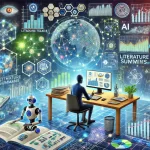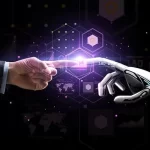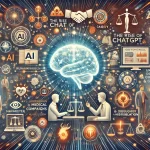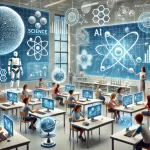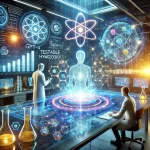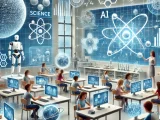
Teaching Artificial Intelligence to Children: A Guide for Educators and Parents
March 27, 2025Artificial Intelligence (AI) has rapidly transitioned from the realm of science fiction to an undeniable force shaping our daily experiences . From the personalized recommendations on streaming platforms to the voice assistants that answer our queries, AI is becoming increasingly integrated into the fabric of modern life. For children growing up in this era, understanding the fundamentals of AI is no longer just a matter of technological curiosity; it is a crucial element of future preparedness across diverse industries . Equipping children with AI literacy early in their education fosters essential life skills, nurturing their creativity, sharpening their critical thinking abilities, enhancing their problem-solving capabilities, and strengthening their logical reasoning . This foundational knowledge empowers them to become informed users and potential innovators in an AI-driven world.
Understanding Age-Appropriate AI Concepts
Introducing AI concepts to children requires a nuanced approach that considers their cognitive development and learning styles. The complexity and depth of information should be carefully tailored to different age groups to ensure effective and engaging learning experiences.
Early Elementary (Ages 5-7): At this stage, the focus should be on introducing the basic idea that machines can follow instructions and identify patterns through playful activities . Simple exercises like sorting objects into categories of “artificial” or “natural” help children distinguish between human-made and naturally occurring items . Comparing how humans use their senses to perceive the world with how machines use sensors like cameras and microphones can also be a relatable way to introduce the concept of machine perception . Engaging in games where children “train” a toy to recognize colors or shapes, or utilizing AI-powered educational games such as Osmo and Kodable, can make learning interactive and fun . The core idea is to establish that AI helps machines “think” and make choices based on the information they are given .
Late Elementary (Ages 8-10): As children mature, they can begin to grasp the concept of learning from data and recognizing patterns . Activities that involve identifying patterns in numbers, colors, or shapes can illustrate how machines also recognize patterns in data . Explaining how AI uses these patterns to perform tasks, such as identifying a cat in a picture, provides a concrete example of machine learning . Visual programming platforms like Tynker and Scratch offer environments where children can create simple AI projects using drag-and-drop coding, further solidifying their understanding . The emphasis shifts to understanding that AI “learns” from information, similar to how they learn from their own experiences .
Middle School (Ages 11-13): Middle schoolers are ready to explore more intricate AI concepts, including machine learning, algorithms, and the decision-making processes of AI systems . The idea that algorithms can be viewed as a set of instructions or even “opinions” can spark critical thinking about how AI operates . Understanding the difference between AI systems that classify or predict and those that generate new content introduces them to the diverse applications of AI . Platforms like Teachable Machine allow students to train their own AI models using images, sounds, or poses, providing a hands-on experience with machine learning . This age group can begin to understand the basic principles behind how AI works and makes choices.
High School (Ages 14-18): Teenagers can engage with advanced AI concepts like neural networks, deep learning, and data science . Exploring the ethical implications of AI, including issues like bias in algorithms and concerns about privacy, becomes increasingly important . Discussions about AI’s impact on society, the job market, and fundamental rights encourage critical thinking about the broader consequences of AI technologies . Resources like Kaggle and Microsoft’s AI for Good initiative offer opportunities for older students to tackle real-world challenges using AI, fostering a deeper understanding of its potential and limitations . At this stage, the focus is on preparing students to be responsible creators and informed users of AI technology, capable of navigating its complex ethical and societal dimensions.
Sample AI Education Syllabi for Kids
Several organizations have developed comprehensive AI education syllabi tailored for children, offering structured pathways for learning. These syllabi vary in their focus and target age groups, providing educators and parents with a range of options.
Day of AI Curriculum (Ages 5-18): This curriculum offers a comprehensive journey into AI literacy and its applications, designed with age-specific lessons and engaging activities . It follows a spiral approach, meaning that fundamental AI concepts are revisited with increasing complexity as students progress through different age groups . For early elementary learners (Ages 5-7), the curriculum introduces the distinction between artificial and natural items and the concept of machines using sensors through interactive activities like sorting objects and comparing human senses to machine sensors . The “What is AI?” unit (Ages 8-18) defines AI, introduces machine learning using data and the Google Quick, Draw! game, and explains algorithms through experiential activities . The “How Do Machines Learn?” unit (Ages 8-18) delves into building AI models using Teachable Machines and explores the potential risks, including algorithmic bias . Generative AI is covered in “How Do Machines Create?” (Ages 8-18), where students learn how AI generates content and examine the ethical implications of deep fakes . For older students, “AI and Ethics” (Ages 10-18) engages them in debates on real-world ethical dilemmas in AI, while “AI Programming Courses with Blocks” (Ages 8-14) and “AI Programming Courses with Python” (Ages 14-18) provide hands-on coding experiences in AI . This curriculum offers a structured and progressive learning experience, introducing foundational concepts to younger children and gradually advancing to more complex topics like programming and ethical considerations for teenagers.
AI + Ethics for Middle School (MIT Media Lab): This syllabus specifically targets middle school students (Ages 11-13) and focuses on the intersection of technical AI concepts and their ethical implications 1 . It introduces students to the process of training simple classifiers and then delves into the ethical considerations that arise from these technical processes, such as algorithmic bias 1 . A key aspect of this curriculum is teaching students to think of algorithms not as neutral entities but as reflections of the data they are trained on, essentially representing “opinions” 1 . Students are also encouraged to consider the various direct and indirect stakeholders who might be affected by AI systems 1 . Through engaging design activities, students are challenged to reimagine familiar AI systems, such as redesigning YouTube’s recommendation algorithm, with a focus on meeting the needs and ethical considerations of diverse stakeholders 1 . The ultimate goal is to empower students to understand that AI can be shaped from both a technical and societal perspective, equipping them with the critical thinking skills to design and interact with AI ethically.
Artificial Intelligence for Kids (The STEMpedia): This curriculum is designed for activity centers, schools, and self-learners, primarily targeting students aged 10 and above, and utilizes a block-coding approach to teach fundamental AI concepts . It covers areas such as computer vision, face detection and recognition, text detection (Optical Character Recognition), speech recognition, and machine learning, all within the accessible environment of graphical programming using PictoBlox . The curriculum comprises 12 lessons with over 10 hands-on activities, estimated to take over 20 learning hours . Lessons range from an “Introduction to Artificial Intelligence,” which differentiates between human and artificial intelligence and explores AI’s applications in tackling global challenges, to practical coding lessons using PictoBlox for “Computer Vision,” where students learn how self-driving cars work, and “Face Detection,” where they create scripts to detect and analyze facial expressions . Other lessons cover “Optical Character Recognition,” where students develop projects similar to Amazon’s delivery system, “Speech Recognition,” where they build virtual assistants, and “Machine Learning,” where they train models to classify images . The curriculum culminates in a “Capstone Project” where students apply their learned concepts to solve a real-world problem . This syllabus provides a practical, hands-on approach to learning AI by engaging students in coding projects that demonstrate real-world AI applications.
Thinking with KIBO AI for Early Grades (KinderLab Robotics): This free 5-lesson unit is specifically designed to introduce core AI concepts to early elementary age children (Ages 5-7) through hands-on activities using the KIBO robot . The curriculum emphasizes the importance of early STEM education, including technology, coding, and AI, to provide young children with an understanding and mastery of AI tools . It recognizes that young children learn most effectively through movement, play, interaction, and engagement with tangible objects, making a physical robot like KIBO an ideal tool for teaching both computer science and artificial intelligence . While specific lesson details are not provided in the snippets, the curriculum aims to encourage critical thinking about how AI tools can be used to improve lives and communities . By using a playful and collaborative STEAM learning robot, this curriculum offers a research-proven method to explore artificial intelligence concepts in early childhood in a way that is both engaging and developmentally appropriate
The following table summarizes the key topics covered in these different syllabi and their respective target age groups:
| Syllabus Name | Target Age Group | Key Topics Covered |
|---|---|---|
| Day of AI Curriculum | 5-18 years | What is AI, How Machines Learn, How Machines Create, AI and Ethics, AI in Creative Arts, AI Programming (Block & Python), AI in Social Media, Data Activism, Careers in AI, Climate Change and AI. |
| AI + Ethics for Middle School (MIT Media Lab) | 11-13 years | Training Simple Classifiers, Algorithmic Bias, Algorithms as Opinions, Stakeholders in AI Systems, Reimagining AI Systems with Ethics. |
| Artificial Intelligence for Kids (The STEMpedia) | 10+ years | Introduction to AI, PictoBlox Basics, Computer Vision, Face Detection, Optical Character Recognition, Speech Recognition, Machine Learning, Pose Classification, AI Ethics, Capstone Project (using block coding). |
| Thinking with KIBO AI for Early Grades (KinderLab) | 5-7 years | Basic AI Concepts, Artificial vs. Natural Items, Machine Sensors, Introduction to AI through Hands-on Activities with KIBO Robot. |
Free Online Resources for Learning AI
The internet offers a wealth of free resources that can be invaluable for teaching AI to children. These resources cater to various learning styles and age groups, making AI education more accessible than ever.
Websites and Articles Explaining Basic AI Concepts: Several websites provide child-friendly explanations of fundamental AI ideas. Day of AI (dayofai.org) offers introductory materials suitable for learners of all ages, making it an excellent starting point for anyone curious about AI . AI4K12.org is another valuable resource, providing interactive materials specifically designed for young children to learn about AI . Google’s Experiments with AI (experiments.withgoogle.com) offers a playful and interactive platform where children can gain hands-on experience with AI and machine learning concepts without needing any prior technical knowledge . LittleLit.ai specializes in introducing AI to children aged 6-14 through relatable examples and engaging, bite-sized lessons, making complex topics easier to understand . Finally, Code.org is a well-established platform for computer science education that now includes a variety of interactive resources for young learners to explore the basics of AI .
Interactive Tools and Platforms: Hands-on experimentation is crucial for effective learning, and several free interactive tools and platforms allow children to engage directly with AI concepts. Scratch (scratch.mit.edu) is a widely used visual programming platform where children can create games, animations, and interactive stories using a drag-and-drop interface. It also features AI extensions like Machine Learning for Kids, enabling students to explore AI concepts such as image recognition and natural language processing in a fun and accessible way . Machine Learning for Kids (machinelearningforkids.co.uk) simplifies the process of training AI models, allowing children to build their own AI projects and gain a practical understanding of machine learning principles . Teachable Machine (teachablemachine.withgoogle.com), a tool from Google, provides an intuitive, code-free way for kids to train their own AI models using photos, sounds, or poses, making the concept of how AI learns from data tangible and understandable . MIT App Inventor (appinventor.mit.edu) is another block-based programming environment that can be used to explore AI concepts, particularly in the context of creating mobile applications . Cognimates (cognimates.me) is an open-source AI education platform where children can build games, program robots, and even train their own AI and machine learning models, offering a comprehensive environment for exploring AI and robotics .
Free Online Courses and Tutorials: Structured learning experiences can be highly beneficial, and several free online courses and tutorials are specifically designed to teach AI to children. Coursera – AI for Kids by Andrew Ng (coursera.org) offers an introductory course to AI fundamentals with a focus on machine learning, making it a great option for beginners . FutureLearn – Introduction to AI (futurelearn.com) provides a beginner-level course that helps children understand both the theoretical and practical applications of AI . While not exclusively focused on AI, Khan Academy (khanacademy.org) offers free classes that cover coding and computing basics, which are essential foundational skills for understanding AI . Create & Learn (create-learn.us) offers various free introductory AI classes for kids, such as “AI Explorers,” which provides a broad overview of AI applications, and “Free Intro to Python Coding,” which introduces a crucial programming language for AI development . Generative AI for Kids, Parents, and Teachers (Coursera) (coursera.org/learn/generative-ai-for-kids) focuses on the rapidly growing field of generative AI, teaching how to use these tools creatively and critically, and is designed for parents and teachers to learn alongside children . Lastly, Free Artificial Intelligence Course for Students (SkillsBuild) (skillsbuild.org/students/course-catalog/artificial-intelligence) offers a foundational understanding of AI, including natural language processing and ethical considerations, and even includes a hands-on project of building a chatbot .
Making Learning Engaging: Games, Simulations, and Visual Aids
Engaging children in AI education requires making the learning process fun and interactive. Games, simulations, and visual aids are powerful tools to achieve this goal.
AI-powered educational games like Osmo, Kodable, and ScratchJr utilize AI algorithms to provide personalized learning experiences for children, helping them develop critical thinking, problem-solving, and coding skills in an enjoyable way . Fun AI-powered games such as Quick Draw, which teaches about shapes and creativity through AI feedback, Talk to Mitsuku, a chatbot that develops communication and problem-solving skills, The Thing Translator, which presents problem-solving and critical thinking challenges, and Freddiemeter, which encourages creative problem-solving and analytical skills, demonstrate the practical applications of AI in engaging formats . Minecraft: Education Edition offers a unique platform for learning by allowing students to design their own simulations and scenarios, fostering collaboration and digital citizenship . AI for Oceans, an educational game from Code.org, introduces the concept of machine learning by having kids train an underwater AI to differentiate between fish and trash, using a relatable story to make the learning process engaging . The AI Playground from MIT RAISE, built on the familiar Scratch platform, provides AI extensions for machine learning, computer vision, and voice recognition, offering a hands-on environment for experimenting with various AI technologies . While not solely focused on AI, PhET Interactive Simulations offer free online math and science simulations that can help build foundational understanding for certain AI concepts by visualizing data, patterns, and algorithms . Finally, Rosebud AI is an innovative AI educational game creator that empowers students and educators to create their own engaging AI video games simply by chatting with an AI assistant, fostering creativity and a deeper understanding of AI principles through game design .
Downloadable Materials: Worksheets, Activity Guides, and Lesson Plans
Free downloadable materials can provide valuable support for educators and parents looking to teach AI to children. The Day of AI Curriculum (dayofai.org/curriculum/) offers downloadable curriculum materials and activities suitable for various grade levels, providing structured lesson plans and hands-on exercises . Several Activity Resource Guides for Teaching Artificial Intelligence in K-12 are available from various sources ), including activities that utilize Scratch and other platforms, catering to different age groups and teaching approaches. For introducing basic AI concepts without computers, resources like 3 Unplugged Activities for Teaching About AI offer valuable alternatives . AI activities for kids and the classroom: Top 10 Hands-On Activities from AIClub provide a mix of both online and offline activities, offering flexibility in teaching methods. Lesson Plans: AI Literacy from Common Sense Education offer ready-to-use lesson plans on essential topics like “What is AI?”, “How is AI trained?”, and “Understanding AI bias.” Machine Learning for Kids Worksheets (machinelearningforkids.co.uk/worksheets) provide downloadable Scratch project worksheets that guide students through various AI concepts through coding . Free AI Resources for Educators from AIClub (corp.aiclub.world/free-ai-resources-teachers) include discussion questions, videos, and hands-on activities that utilize online tools and require no installation . TeachAI Resources (ai-4-all.org/teachai/) offer a comprehensive collection of AI education materials, including lesson plans and activities from a dedicated organization . Lastly, CRAFT AI Literacy Resources (craft.stanford.edu/) provide free AI literacy materials specifically for high school teachers, including lessons on algorithmic bias and AI applications, tailored for older students .
Open-Source AI Education Platforms and Communities
Open-source platforms and communities offer valuable resources and collaborative environments for learning about AI. Cognimates (cognimates.me) is an open-source AI education platform where children can engage in innovative programming activities, build games, program robots, and train their own AI and machine-learning models, fostering a community-driven approach to learning . Playlab (playlab.ai) is another open-source platform that empowers educators and students to create AI tools tailored to their specific educational needs, build AI literacy through hands-on workshops, and experiment with AI responsibly within a supportive community . While primarily a visual programming language, Scratch (scratch.mit.edu), with its open and free nature and vast community of users sharing projects, serves as an invaluable open-source resource for AI education through its extensions and the multitude of AI-related projects created and shared by its community . These platforms encourage collaboration, provide flexibility for customization, and offer a rich learning environment where users can learn from each other’s experiences and creations.
Leveraging Scratch for AI Education
Scratch, with its user-friendly, block-based interface, stands out as an exceptionally accessible tool for introducing AI concepts to children . Its drag-and-drop coding system simplifies programming, making it approachable for kids with no prior coding experience, allowing them to focus on the underlying logic and AI principles rather than complex syntax . The Machine Learning for Kids extension seamlessly integrates AI functionalities into Scratch, enabling students to create projects that involve image recognition, chatbots, and even emotion detection through practical, hands-on applications . A step-by-step example, such as creating a “Waste Wise: AI Trash Sorter” project , demonstrates how children can train an AI model to classify recyclable and non-recyclable items, providing a concrete understanding of image classification and supervised learning. Numerous other project ideas, including building a TravelBot Trek chatbot, a Feel-o-Meter for emotion detection, a WikiSaurus Adventure for image recognition, a Guess the Image game, and a PetPal AI assistant, offer a diverse range of engaging activities to spark creativity and reinforce AI learning . Furthermore, Scratch Lab’s Face Sensing blocks provide an experimental avenue for creating games and interactive stories that respond to facial features, offering an accessible introduction to predictive AI technologies . While Scratch is excellent for introducing fundamental chatbot concepts through keyword matching, it is important to note its limitations for more advanced natural language processing tasks, suggesting that other tools might be necessary for older students seeking a more sophisticated chatbot development experience . Overall, Scratch provides a powerful and versatile platform for making AI education fun, interactive, and accessible to children of various ages.
Conclusion: Empowering the Next Generation with AI Knowledge
Introducing AI education to children at an early age offers significant benefits, fostering crucial skills and preparing them for a future where AI will play an increasingly dominant role . The abundance of free online resources, including comprehensive syllabi, interactive tools, engaging games, downloadable materials, and supportive open-source platforms, makes teaching and learning AI more accessible than ever before [various snippets]. Parents and educators are encouraged to explore these readily available resources and integrate AI learning into children’s education in a way that is both fun and engaging. By starting with age-appropriate concepts and gradually increasing complexity, children can develop a strong foundation in AI literacy, empowering them to become not just consumers but also creators and critical thinkers in the age of artificial intelligence.
LINKS TO RESOURCES




